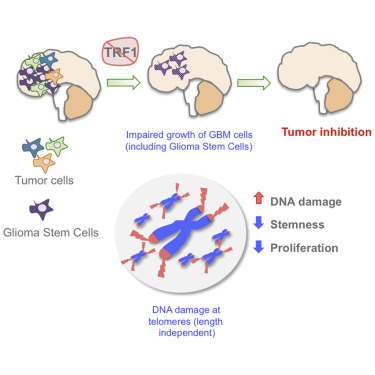当前位置:
X-MOL 学术
›
Cancer Cell
›
论文详情
Our official English website, www.x-mol.net, welcomes your
feedback! (Note: you will need to create a separate account there.)
Inhibition of TRF1 Telomere Protein Impairs Tumor Initiation and Progression in Glioblastoma Mouse Models and Patient-Derived Xenografts.
Cancer Cell ( IF 48.8 ) Pub Date : 2017-11-13 , DOI: 10.1016/j.ccell.2017.10.006 Leire Bejarano 1 , Alberto J Schuhmacher 2 , Marinela Méndez 1 , Diego Megías 3 , Carmen Blanco-Aparicio 4 , Sonia Martínez 4 , Joaquín Pastor 4 , Massimo Squatrito 2 , Maria A Blasco 1
Cancer Cell ( IF 48.8 ) Pub Date : 2017-11-13 , DOI: 10.1016/j.ccell.2017.10.006 Leire Bejarano 1 , Alberto J Schuhmacher 2 , Marinela Méndez 1 , Diego Megías 3 , Carmen Blanco-Aparicio 4 , Sonia Martínez 4 , Joaquín Pastor 4 , Massimo Squatrito 2 , Maria A Blasco 1
Affiliation

|
Glioblastoma multiforme (GBM) is a deadly and common brain tumor. Poor prognosis is linked to high proliferation and cell heterogeneity, including glioma stem cells (GSCs). Telomere genes are frequently mutated. The telomere binding protein TRF1 is essential for telomere protection, and for adult and pluripotent stem cells. Here, we find TRF1 upregulation in mouse and human GBM. Brain-specific Trf1 genetic deletion in GBM mouse models inhibited GBM initiation and progression, increasing survival. Trf1 deletion increased telomeric DNA damage and reduced proliferation and stemness. TRF1 chemical inhibitors mimicked these effects in human GBM cells and also blocked tumor sphere formation and tumor growth in xenografts from patient-derived primary GSCs. Thus, targeting telomeres throughout TRF1 inhibition is an effective therapeutic strategy for GBM.
中文翻译:

抑制 TRF1 端粒蛋白会损害胶质母细胞瘤小鼠模型和患者来源的异种移植物中的肿瘤起始和进展。
多形性胶质母细胞瘤 (GBM) 是一种致命且常见的脑肿瘤。不良预后与高增殖和细胞异质性有关,包括胶质瘤干细胞 (GSC)。端粒基因经常发生突变。端粒结合蛋白 TRF1 对端粒保护以及成体和多能干细胞至关重要。在这里,我们发现小鼠和人类 GBM 中的 TRF1 上调。GBM 小鼠模型中大脑特异性的 Trf1 基因缺失抑制了 GBM 的发生和进展,从而提高了存活率。Trf1 缺失增加了端粒 DNA 损伤并降低了增殖和干性。TRF1 化学抑制剂在人类 GBM 细胞中模拟了这些作用,并且还阻止了来自患者的原代 GSC 异种移植物中的肿瘤球形成和肿瘤生长。因此,在整个 TRF1 抑制过程中靶向端粒是 GBM 的有效治疗策略。
更新日期:2017-11-13
中文翻译:

抑制 TRF1 端粒蛋白会损害胶质母细胞瘤小鼠模型和患者来源的异种移植物中的肿瘤起始和进展。
多形性胶质母细胞瘤 (GBM) 是一种致命且常见的脑肿瘤。不良预后与高增殖和细胞异质性有关,包括胶质瘤干细胞 (GSC)。端粒基因经常发生突变。端粒结合蛋白 TRF1 对端粒保护以及成体和多能干细胞至关重要。在这里,我们发现小鼠和人类 GBM 中的 TRF1 上调。GBM 小鼠模型中大脑特异性的 Trf1 基因缺失抑制了 GBM 的发生和进展,从而提高了存活率。Trf1 缺失增加了端粒 DNA 损伤并降低了增殖和干性。TRF1 化学抑制剂在人类 GBM 细胞中模拟了这些作用,并且还阻止了来自患者的原代 GSC 异种移植物中的肿瘤球形成和肿瘤生长。因此,在整个 TRF1 抑制过程中靶向端粒是 GBM 的有效治疗策略。









































 京公网安备 11010802027423号
京公网安备 11010802027423号